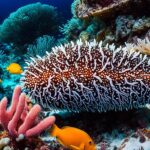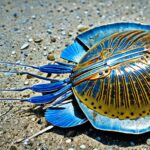Let’s explore the world of horseshoe crabs and a big question: Are they endangered? These ancient sea creatures are crucial to coastal ecosystems, having thrived for over 450 million years. But, their numbers are dropping fast because of overfishing and habitat loss. Now, there are efforts to protect them, including petitions to list the American horseshoe crab as endangered. It’s important to know about the threats they face and how we can help them.
Understanding Horseshoe Crabs: A Brief Overview
Horseshoe crabs are fascinating creatures that have caught the eye of scientists and conservationists. Their evolutionary significance is huge, showing how they’ve lasted over 450 million years. They’ve survived many big events, proving their ability to adapt and stay alive in a changing world.
Learning about these ancient creatures helps us understand their role in today’s oceans. It’s especially important for their horseshoe crab conservation status.
Fossil Record and Evolutionary Significance
The fossil record shows how long horseshoe crabs have been around. They’ve made it through five big extinction events, which is amazing. Their evolution is key to their survival.
They are more like arachnids than true crabs, showing a big change in marine life. This makes them very important for understanding how life has changed over time.
Biological Characteristics of Horseshoe Crabs
The biological characteristics of horseshoe crabs are quite interesting. They have a hard shell that protects them and a long tail for moving and righting themselves. They have ten eyes to see light and movement.
They have special breeding habits, moving from deep water to beaches to spawn during spring tides. This helps them survive and move through the ocean.
| Feature | Description |
|---|---|
| Lineage Age | Over 450 million years |
| Survival Events | Survived five mass extinctions |
| Closely Related To | Arachnids |
| Eyes | Ten eyes for light detection |
| Breeding Behavior | Migrate to sandy beaches for spawning |
Current Conservation Status of Horseshoe Crabs
The conservation status of horseshoe crabs is worrying. Their IUCN listing and global distribution show the challenges they face. These ancient creatures are facing big changes in their populations. Researchers are looking into the trends and causes behind these changes.
IUCN Listing and Global Distribution
The American horseshoe crab (Limulus polyphemus) is listed as “Vulnerable” by the IUCN. This means their numbers are getting smaller. They live mainly in the Atlantic and Gulf coasts of the United States and parts of Mexico. These areas are key for their breeding and growth.
But, their homes are being affected by urban growth and climate change. This makes their global distribution more at risk.
Horseshoe Crab Population Trends
Studies show worrying trends in horseshoe crab populations, like in Delaware Bay. Over 30 years, more than 66% of these crabs have disappeared from this important area. This big drop is a warning sign for their future and highlights the need for conservation efforts.
| Region | IUCN Status | Population Decline (%) |
|---|---|---|
| Delaware Bay | Vulnerable | 66 |
| Gulf Coast | Vulnerable | Varies |
| Caribbean | Least Concern | Stable |
Are horseshoe crabs endangered?
In recent years, there’s growing worry about the decline of horseshoe crabs. They play a key role in marine ecosystems. It’s important to know why their numbers are dropping. We must act to protect them and the ecosystems they live in.
Evidence of Population Decline
The main reason for the decline is overfishing. People catch them for bait and for medical uses. This has greatly reduced their numbers. Conservationists are calling for better management and sustainable fishing to help them.
Legal Protections and Status under the Endangered Species Act
There’s a push for stronger laws to protect horseshoe crabs. Some want them listed under the Endangered Species Act. This could help them recover and keep marine ecosystems healthy.
Threats to Horseshoe Crab Population
The horseshoe crab population is facing big challenges that threaten their survival. Overharvesting, habitat destruction, and climate change are the main threats. These threats show why conservation efforts are so important.
Overharvesting for Biomedical Uses
Many horseshoe crabs are taken from the ocean for their blue blood. This blood is vital for making vaccines. Every year, around 700,000 crabs are removed from the wild. This high number raises big concerns about their future.
Impact of Habitat Destruction on Horseshoe Crab Breeding
Habitat destruction is a big problem for horseshoe crabs. When beaches are built on or protected with hard structures, it takes away their breeding spots. This makes it harder for them to reproduce and survive.
Effects of Climate Change on Spawning Grounds
Climate change is also a big threat to horseshoe crabs. Rising sea levels and warmer temperatures can destroy their homes. This makes it harder for them to have babies and survive.
The Importance of Horseshoe Crabs in Marine Ecosystems
Horseshoe crabs are key to keeping marine ecosystems healthy. They help protect marine life by supporting many species. These ancient creatures play a big role in the balance of their environments.
Role in Marine Biodiversity Conservation
Horseshoe crabs are important because they keep marine environments balanced. Many other animals depend on them for their homes and survival. Keeping horseshoe crabs safe helps keep the ocean’s biodiversity strong. This is crucial because losing a key species can harm the entire ecosystem.
Food Source for Migratory Species like the Red Knot
Horseshoe crab eggs are a vital food for many migratory birds, like the red knot. These birds need the eggs to regain energy during their long journeys. This shows how crucial horseshoe crabs are for these birds’ survival.
| Species | Dependence on Horseshoe Crabs | Migration Period |
|---|---|---|
| Red Knot | High—relies on eggs during migration | Spring and Fall |
| Other Shorebirds | Moderate—utilizes eggs as a food resource | Varies by species |
Ongoing Horseshoe Crab Conservation Efforts
To fight the challenges facing horseshoe crabs, many conservation efforts are happening. Various groups are key in protecting this ancient species. They work on projects to help horseshoe crabs in different places.
Organizations Advocating for Horseshoe Crab Protection
Many groups focus on saving horseshoe crabs. Some top ones are:
- The Center for Biological Diversity
- American Bird Conservancy
- The Humane Society of the United States
These groups work together on activism, research, and pushing for laws. Their goal is to make policies that help and inform people about horseshoe crabs’ importance in the ocean.
Community Engagement and Local Restoration Projects
Getting the community involved is key to saving horseshoe crabs. Local projects focus on keeping their homes safe. They use volunteers and teach people to care for the environment.
By working together, communities learn more about protecting nature. They also help the places where horseshoe crabs live.

What You Can Do to Help Horseshoe Crabs
Your efforts can make a big difference for horseshoe crabs. Supporting sustainable fishing and pushing for laws to protect them is key. By choosing fishing methods that catch fewer other animals, you help horseshoe crabs and the ocean.
Joining local beach cleanups is a great way to help horseshoe crabs. Cleaning up the beach reduces the chance of them getting tangled in trash. You can also help by volunteering with groups that protect horseshoe crabs, assisting with research or teaching others.
Sharing what you know on social media or at community events can also make a big impact. Teaching others about the importance of protecting horseshoe crabs encourages everyone to act together. By doing these simple things, you play a big role in saving horseshoe crabs for the future.
FAQ
Are horseshoe crabs endangered?
The American horseshoe crab is listed as “Vulnerable” by the IUCN. There are efforts to list it as endangered under the Endangered Species Act. This is because their numbers have greatly decreased.
What factors are contributing to the decline of horseshoe crab populations?
Overfishing for bait and biomedical purposes, habitat loss, and climate change are the main reasons. These issues harm their breeding grounds.
What does the IUCN listing imply for horseshoe crabs?
Being listed as “Vulnerable” means horseshoe crabs are at high risk of extinction. This calls for immediate action to save their populations and homes.
How do horseshoe crabs contribute to marine biodiversity?
They are vital to marine life. They feed many animals, like the red knot, which needs their eggs during migration.
What conservation efforts are being made to protect horseshoe crabs?
Groups like the Center for Biological Diversity and American Bird Conservancy are fighting for their protection. They use activism, research, and local projects to save their habitats.
How can I help in the conservation of horseshoe crabs?
You can help by supporting sustainable fishing, joining beach cleanups, and backing organizations that protect horseshoe crabs. Also, spread the word in your community.







